
- July 19, 2024 | New Study Links Anxiety in Young Women to Brain Chemical Imbalance
- July 19, 2024 | The Galactic Pulse: Pulsar Timing Arrays Detect Long-Period Gravitational Waves
- July 19, 2024 | Challenging Current Timelines: New Fossil Finds Suggest Early Humans in South America Over 20,000 Years Ago
- July 19, 2024 | Revolutionary AI Method Creates Precise Material “Fingerprints”
- July 19, 2024 | Hidden Connection Discovered: New Research Links Brain Inflammation to Muscle Fatigue

Flashback 1977: NASA’s Voyager 1 Lifts Off Toward an Interstellar Journey
By NASA September 5, 2023
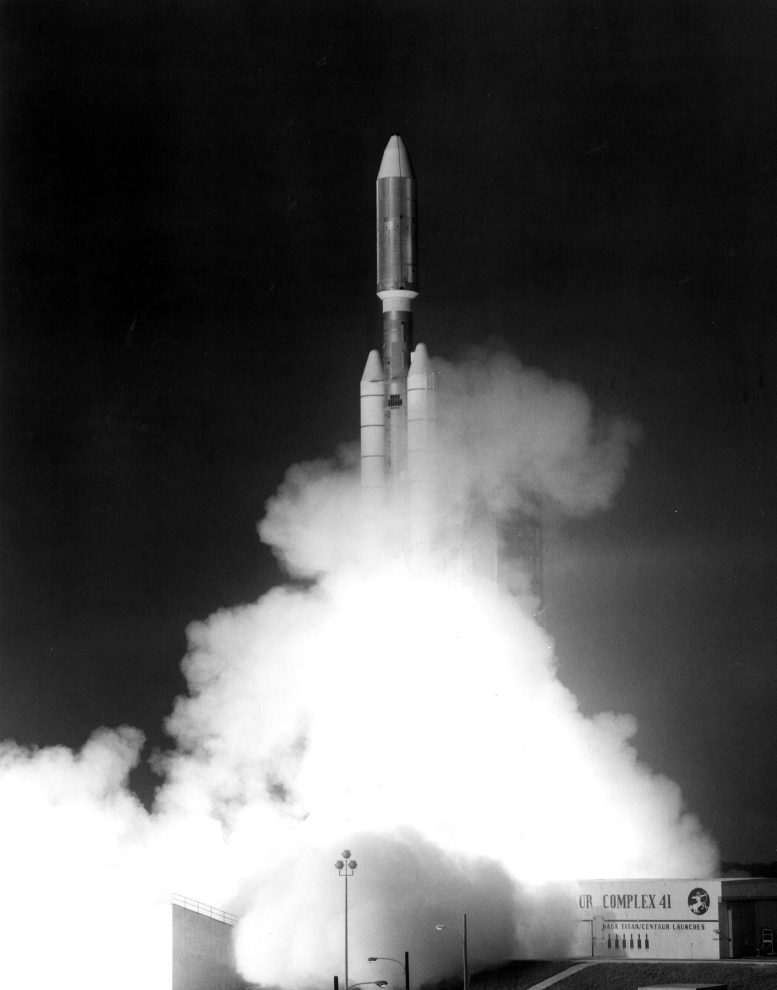
NASA’s Voyager 1 spacecraft lifts off atop its Titan/Centaur-6 launch vehicle on September 5, 1977, from Launch Complex 41 at Cape Canaveral Air Force Station, now Cape Canaveral Space Force Station, in Florida. Credit: NASA
On September 5, 1977, NASA ’s Voyager 1 spacecraft lifted off atop its Titan/Centaur-6 launch vehicle from Launch Complex 41 at Cape Canaveral Air Force Station, now Cape Canaveral Space Force Station, in Florida.
Voyager 1 and its twin, Voyager 2, were originally launched to conduct closeup studies of Jupiter and Saturn , Saturn’s rings, and the larger moons of the two planets. After completing these missions and more , Voyager 1 became the first spacecraft to reach interstellar space and is now the farthest human-made object from Earth. Scientists think it will reach the inner edge of the Oort Cloud in 300 years.
Follow along with Voyager’s live mission status .
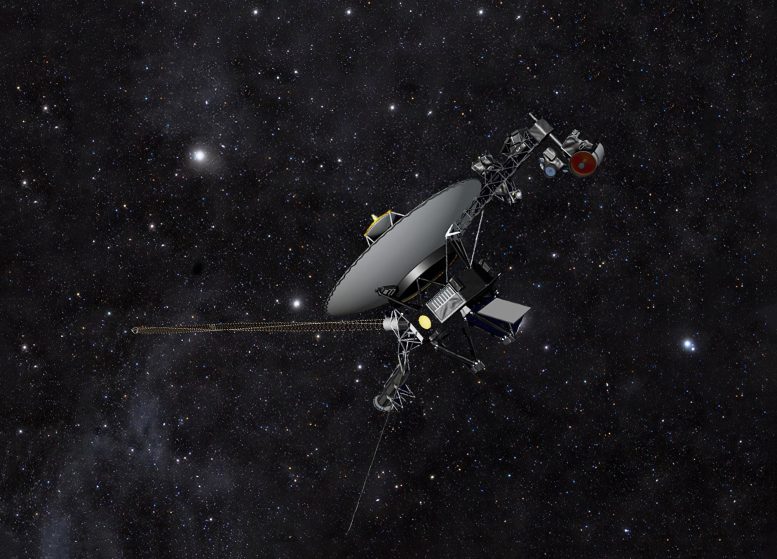
This artist’s concept shows NASA’s Voyager spacecraft against a field of stars in the darkness of space. The two Voyager spacecraft are traveling farther and farther away from Earth, on a journey to interstellar space, and will eventually circle around the center of the Milky Way galaxy. Credit: NASA/JPL-Caltech
The Voyager missions, launched by NASA in 1977, consist of two spacecraft: Voyager 1 and Voyager 2. These missions were initially intended to study the outer planets of our Solar System, particularly the gas giants Jupiter and Saturn. Both probes provided unprecedented observations and data on these planets, their major moons, and their ring systems.
Voyager 2, in an extended mission, continued on to Uranus and Neptune , becoming the first (and, to date, the only) spacecraft to visit these outer planets. Both Voyager 1 and 2 are equipped with the “Golden Records,” which carry sounds and images selected to portray the diversity of life on Earth for any extraterrestrial beings that might encounter the probes.
Following their planetary missions, both spacecraft have continued to journey outward, sending back data from the far reaches of our Solar System. As of September 5, 2023, Voyager 1, the most distant human-made object from Earth, is 14.97 million miles away, and Voyager 2 is 12.44 million miles away.
The Voyager missions have significantly expanded our understanding of the Solar System and continue to send back data, providing insights into the space environment outside of our planet’s protective bubble.
More on SciTechDaily
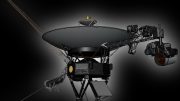
NASA’s Longest-Lived Mission: Voyager Probes Log 45 Years in Space

2021 Was an Amazing Year for NASA: Mars Landing, First Flight, Artemis, More [Video]

It’s Official – Voyager 1 Has Entered Interstellar Space
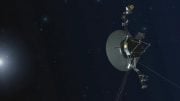
Voyager 2 Illuminates Boundary of Interstellar Space 11 Billion Miles From Earth
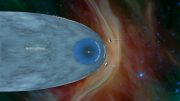
Voyager 2 Probe Enters Interstellar Space, Over 18 Billion Kilometers from Earth
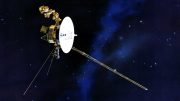
Voyager Spacecraft Poised to Make New Discoveries
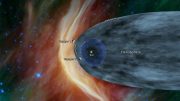
Hear the Eerie Sounds of Interstellar Space Captured by NASA’s Voyager
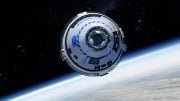
What You Need To Know About NASA’s Boeing Starliner Spacecraft Launch + How To Watch It Live
1 comment on "flashback 1977: nasa’s voyager 1 lifts off toward an interstellar journey".
The distances from earth are incorrect. I think the distances are in billions of miles, not millions
Leave a comment Cancel reply
Email address is optional. If provided, your email will not be published or shared.
Save my name, email, and website in this browser for the next time I comment.
Voyager 1: Facts about Earth's farthest spacecraft
Voyager 1 continues to explore the cosmos along with its twin probe, Voyager 2.
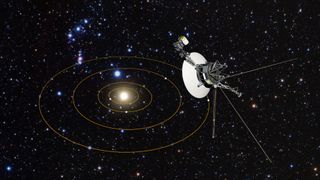
The Grand Tour
Voyager 1 jupiter flyby, voyager 1 visits saturn and its moons, voyager 1 enters interstellar space, voyager 1's interstellar adventures, additional resources.
Voyager 1 is the first spacecraft to travel beyond the solar system and reach interstellar space .
The probe launched on Sept. 5, 1977 — about two weeks after its twin Voyager 2 — and as of August 2022 is approximately 14.6 billion miles (23.5 billion kilometers) away from our planet, making it Earth 's farthest spacecraft. Voyager 1 is currently zipping through space at around 38,000 mph (17 kilometers per second), according to NASA Jet Propulsion Laboratory .
When Voyager 1 launched a mission to explore the outer planets in our solar system nobody knew how important the probe would still be 45 years later The probe has remained operational long past expectations and continues to send information about its journeys back to Earth.
Related: Celebrate 45 years of Voyager with these amazing images of our solar system (gallery)
Elizabeth Howell, Ph.D., is a staff writer in the spaceflight channel since 2022. She was contributing writer for Space.com for 10 years before that, since 2012. Elizabeth's on-site reporting includes two human spaceflight launches from Kazakhstan, three space shuttle missions in Florida, and embedded reporting from a simulated Mars mission in Utah.
Size: Voyager 1's body is about the size of a subcompact car. The boom for its magnetometer instrument extends 42.7 feet (13 meters). Weight (at launch): 1,797 pounds (815 kilograms). Launch date: Sept. 5, 1977
Jupiter flyby date: March 5, 1979
Saturn flyby date: Nov. 12, 1980.
Entered interstellar space: Aug. 25, 2012.
The spacecraft entered interstellar space in August 2012, almost 35 years after its voyage began. The discovery wasn't made official until 2013, however, when scientists had time to review the data sent back from Voyager 1.
Voyager 1 was the second of the twin spacecraft to launch, but it was the first to race by Jupiter and Saturn . The images Voyager 1 sent back have been used in schoolbooks and by many media outlets for a generation. The spacecraft also carries a special record — The Golden Record — that's designed to carry voices and music from Earth out into the cosmos.
According to NASA Jet Propulsion Laboratory (JPL) , Voyager 1 has enough fuel to keep its instruments running until at least 2025. By then, the spacecraft will be approximately 13.8 billion miles (22.1 billion kilometers) away from the sun.
The Voyager missions took advantage of a special alignment of the outer planets that happens just once every 176 years. This alignment allows spacecraft to gravitationally "slingshot" from one planet to the next, making the most efficient use of their limited fuel.
NASA originally planned to send two spacecraft past Jupiter, Saturn and Pluto and two other probes past Jupiter, Uranus and Neptune . Budgetary reasons forced the agency to scale back its plans, but NASA still got a lot out of the two Voyagers it launched.
Voyager 2 flew past Jupiter, Saturn, Uranus and Neptune , while Voyager 1 focused on Jupiter and Saturn.
Recognizing that the Voyagers would eventually fly to interstellar space, NASA authorized the production of two Golden Records to be placed on board the spacecraft. Sounds ranging from whale calls to the music of Chuck Berry were placed on board, as well as spoken greetings in 55 languages.
The 12-inch-wide (30 centimeters), gold-plated copper disks also included pictorials showing how to operate them and the position of the sun among nearby pulsars (a type of fast-spinning stellar corpse known as a neutron star ), in case extraterrestrials someday stumbled onto the spacecraft and wondered where they came from.
Both spacecraft are powered by three radioisotope thermoelectric generators , devices that convert the heat released by the radioactive decay of plutonium to electricity. Both probes were outfitted with 10 scientific instruments, including a two-camera imaging system, multiple spectrometers, a magnetometer and gear that detects low-energy charged particles and high-energy cosmic rays . Mission team members have also used the Voyagers' communications system to help them study planets and moons, bringing the total number of scientific investigations on each craft to 11.
Voyager 1 almost didn't get off the ground at its launch , as its rocket came within 3.5 seconds of running out of fuel on Sept. 5, 1977.
But the probe made it safely to space and raced past its twin after launch, getting beyond the main asteroid belt between Mars and Jupiter before Voyager 2 did. Voyager 1's first pictures of Jupiter beamed back to Earth in April 1978, when the probe was 165 million miles (266 million kilometers) from home.
According to NASA , each voyager probe has about 3 million times less memory than a mobile phone and transmits data approximately 38,000 times slower than a 5g internet connection.
To NASA's surprise, in March 1979 Voyager 1 spotted a thin ring circling the giant planet. It found two new moons as well — Thebe and Metis. Additionally, Voyager 1 sent back detailed pictures of Jupiter's big Galilean moons ( Io , Europa , Ganymede and Callisto ) as well as Amalthea .
Like the Pioneer spacecraft before it , Voyager's look at Jupiter's moons revealed them to be active worlds of their own. And Voyager 1 made some intriguing discoveries about these natural satellites. For example, Io's many volcanoes and mottled yellow-brown-orange surface showed that, like planets, moons can have active interiors.
Additionally, Voyager 1 sent back photos of Europa showing a relatively smooth surface broken up by lines, hinting at ice and maybe even an ocean underneath. (Subsequent observations and analyses have revealed that Europa likely harbors a huge subsurface ocean of liquid water, which may even be able to support Earth-like life .)
Voyager 1's closest approach to Jupiter was on March 5, 1979, when it came within 174,000 miles (280,000 km) of the turbulent cloud tops. Then it was time for the probe to aim for Saturn.
Scientists only had to wait about a year, until 1980, to get close-up pictures of Saturn. Like Jupiter, the ringed planet turned out to be full of surprises.
One of Voyager 1's targets was the F ring, a thin structure discovered only the year previously by NASA's Pioneer 11 probe. Voyager's higher-resolution camera spotted two new moons, Prometheus and Pandora, whose orbits keep the icy material in the F ring in a defined orbit. It also discovered Atlas and a new ring, the G ring, and took images of several other Saturn moons.
One puzzle for astronomers was Titan , the second-largest moon in the solar system (after Jupiter's Ganymede). Close-up pictures of Titan showed nothing but orange haze, leading to years of speculation about what it was like underneath. It wouldn't be until the mid-2000s that humanity would find out, thanks to photos snapped from beneath the haze by the European Space Agency's Huygens atmospheric probe .
The Saturn encounter marked the end of Voyager 1's primary mission. The focus then shifted to tracking the 1,590-pound (720 kg) craft as it sped toward interstellar space.
Two decades before it notched that milestone, however, Voyager 1 took one of the most iconic photos in spaceflight history. On Feb. 14, 1990, the probe turned back toward Earth and snapped an image of its home planet from 3.7 billion miles (6 billion km) away. The photo shows Earth as a tiny dot suspended in a ray of sunlight.
Voyager 1 took dozens of other photos that day, capturing five other planets and the sun in a multi-image "solar system family portrait." But the Pale Blue Dot picture stands out, reminding us that Earth is a small outpost of life in an incomprehensibly vast universe.
Voyager 1 left the heliosphere — the giant bubble of charged particles that the sun blows around itself — in August 2012, popping free into interstellar space. The discovery was made public in a study published in the journal Science the following year.
The results came to light after a powerful solar eruption was recorded by Voyager 1's plasma wave instrument between April 9 and May 22, 2013. The eruption caused electrons near Voyager 1 to vibrate. From the oscillations, researchers discovered that Voyager 1's surroundings had a higher density than what is found just inside the heliosphere.
It seems contradictory that electron density is higher in interstellar space than it is in the sun's neighborhood. But researchers explained that, at the edge of the heliosphere, the electron density is dramatically low compared with locations near Earth.
Researchers then backtracked through Voyager 1's data and nailed down the official departure date to Aug. 25, 2012. The date was fixed not only by the electron oscillations but also by the spacecraft's measurements of charged solar particles.
On that fateful day — which was the same day that Apollo 11 astronaut Neil Armstrong died — the probe saw a 1,000-fold drop in these particles and a 9% increase in galactic cosmic rays that come from outside the solar system . At that point, Voyager 1 was 11.25 billion miles (18.11 billion km) from the sun, or about 121 astronomical units (AU).
One AU is the average Earth-sun distance — about 93 million miles (150 million km).
You can keep tabs on the Voyager 1's current distance and mission status on this NASA website .
Since flying into interstellar space, Voyager 1 has sent back a variety of valuable information about conditions in this zone of the universe . Its discoveries include showing that cosmic radiation out there is very intense, and demonstrating how charged particles from the sun interact with those emitted by other stars , mission project scientist Ed Stone, of the California Institute of Technology in Pasadena, told Space.com in September 2017 .
The spacecraft's capabilities continue to astound engineers. In December 2017, for example, NASA announced that Voyager 1 successfully used its backup thrusters to orient itself to "talk" with Earth . The trajectory correction maneuver (TCM) thrusters hadn't been used since November 1980, during Voyager 1's flyby of Saturn. Since then, the spacecraft had primarily used its standard attitude-control thrusters to swing the spacecraft in the right orientation to communicate with Earth.
As the performance of the attitude-control thrusters began to deteriorate, however, NASA decided to test the TCM thrusters — an idea that could extend Voyager 1's operational life. That test ultimately succeeded.
"With these thrusters that are still functional after 37 years without use, we will be able to extend the life of the Voyager 1 spacecraft by two to three years," Voyager project manager Suzanne Dodd, of NASA's Jet Propulsion, Laboratory (JPL) in Southern California, said in a statement in December 2017 .
Mission team members have taken other measures to extend Voyager 1's life as well. For example, they turned off the spacecraft's cameras shortly after the Pale Blue Dot photo was taken to help conserve Voyager 1's limited power supply. (The cameras wouldn't pick up much in the darkness of deep space anyway.) Over the years, the mission team has turned off five other scientific instruments as well, leaving Voyager 1 with four that are still functioning — the Cosmic Ray Subsystem, the Low-Energy Charged Particles instrument, the Magnetometer and the Plasma Wave Subsystem. (Similar measures have been taken with Voyager 2, which currently has five operational instruments .)
The Voyager spacecraft each celebrated 45 years in space in 2022, a monumental milestone for the twin probes.
"Over the last 45 years, the Voyager missions have been integral in providing this knowledge and have helped change our understanding of the sun and its influence in ways no other spacecraft can," says Nicola Fox, director of the Heliophysics Division at NASA Headquarters in Washington, in a NASA statement .
"Today, as both Voyagers explore interstellar space, they are providing humanity with observations of uncharted territory," said Linda Spilker, Voyager's deputy project scientist at JPL in the same NASA statement.
"This is the first time we've been able to directly study how a star, our Sun, interacts with the particles and magnetic fields outside our heliosphere, helping scientists understand the local neighborhood between the stars, upending some of the theories about this region, and providing key information for future missions." Spilker continues.
Voyager 1's next big encounter will take place in 40,000 years when the probe comes within 1.7 light-years of the star AC +79 3888. (The star is roughly 17.5 light-years from Earth.) However, Voyager 1's falling power supply means it will probably stop collecting scientific data around 2025.
You can learn much more about both Voyagers' design, scientific instruments and mission goals at JPL's Voyager site . NASA has lots of in-depth information about the Pale Blue Dot photo, including Carl Sagan's large role in making it happen, here . And if you're interested in the Golden Record, check out this detailed New Yorker piece by Timothy Ferris, who produced the historic artifact. Explore the history of Voyager with this interactive timeline courtesy of NASA.
Bibliography
- Bell, Jim. " The Interstellar Age: Inside the Forty-Year Voyager Mission ," Dutton, 2015.
- Landau, Elizabeth. "The Voyagers in popular culture," Dec. 1, 2017. https://www.nasa.gov/feature/jpl/the-voyagers-in-popular-culture
- PBS, "Voyager: A history in photos." https://www.pbs.org/the-farthest/mission/voyager-history-photos/
Join our Space Forums to keep talking space on the latest missions, night sky and more! And if you have a news tip, correction or comment, let us know at: [email protected].
Get the Space.com Newsletter
Breaking space news, the latest updates on rocket launches, skywatching events and more!
Elizabeth Howell (she/her), Ph.D., is a staff writer in the spaceflight channel since 2022 covering diversity, education and gaming as well. She was contributing writer for Space.com for 10 years before joining full-time. Elizabeth's reporting includes multiple exclusives with the White House and Office of the Vice-President of the United States, an exclusive conversation with aspiring space tourist (and NSYNC bassist) Lance Bass, speaking several times with the International Space Station, witnessing five human spaceflight launches on two continents, flying parabolic, working inside a spacesuit, and participating in a simulated Mars mission. Her latest book, " Why Am I Taller ?", is co-written with astronaut Dave Williams. Elizabeth holds a Ph.D. and M.Sc. in Space Studies from the University of North Dakota, a Bachelor of Journalism from Canada's Carleton University and a Bachelor of History from Canada's Athabasca University. Elizabeth is also a post-secondary instructor in communications and science at several institutions since 2015; her experience includes developing and teaching an astronomy course at Canada's Algonquin College (with Indigenous content as well) to more than 1,000 students since 2020. Elizabeth first got interested in space after watching the movie Apollo 13 in 1996, and still wants to be an astronaut someday. Mastodon: https://qoto.org/@howellspace
- Daisy Dobrijevic Reference Editor
'Space can unite a troubled country in troubled times': NASA chief calls for unity 55 years after Apollo 11 moon landing
NASA delays ISS spacewalks indefinitely to investigate spacesuit coolant leak
Firefly Aerospace CEO leaves company amid misconduct investigation
Most Popular
- 2 The sun's next solar cycle has begun, 'starquakes' suggest
- 3 Polaris Dawn crew shows off new SpaceX spacesuits for 1st private spacewalk (photos)
- 4 NASA delays ISS spacewalks indefinitely to investigate spacesuit coolant leak
- 5 A high-speed particle struck the Gaia space telescope — but Gaia came back stronger than ever
We’re fighting to restore access to 500,000+ books in court this week. Join us!
Internet Archive Audio

- This Just In
- Grateful Dead
- Old Time Radio
- 78 RPMs and Cylinder Recordings
- Audio Books & Poetry
- Computers, Technology and Science
- Music, Arts & Culture
- News & Public Affairs
- Spirituality & Religion
- Radio News Archive

- Flickr Commons
- Occupy Wall Street Flickr
- NASA Images
- Solar System Collection
- Ames Research Center

- All Software
- Old School Emulation
- MS-DOS Games
- Historical Software
- Classic PC Games
- Software Library
- Kodi Archive and Support File
- Vintage Software
- CD-ROM Software
- CD-ROM Software Library
- Software Sites
- Tucows Software Library
- Shareware CD-ROMs
- Software Capsules Compilation
- CD-ROM Images
- ZX Spectrum
- DOOM Level CD

- Smithsonian Libraries
- FEDLINK (US)
- Lincoln Collection
- American Libraries
- Canadian Libraries
- Universal Library
- Project Gutenberg
- Children's Library
- Biodiversity Heritage Library
- Books by Language
- Additional Collections

- Prelinger Archives
- Democracy Now!
- Occupy Wall Street
- TV NSA Clip Library
- Animation & Cartoons
- Arts & Music
- Computers & Technology
- Cultural & Academic Films
- Ephemeral Films
- Sports Videos
- Videogame Videos
- Youth Media
Search the history of over 866 billion web pages on the Internet.
Mobile Apps
- Wayback Machine (iOS)
- Wayback Machine (Android)
Browser Extensions
Archive-it subscription.
- Explore the Collections
- Build Collections
Save Page Now
Capture a web page as it appears now for use as a trusted citation in the future.
Please enter a valid web address
- Donate Donate icon An illustration of a heart shape

Audio With External Links Item Preview
Share or embed this item, flag this item for.
- Graphic Violence
- Explicit Sexual Content
- Hate Speech
- Misinformation/Disinformation
- Marketing/Phishing/Advertising
- Misleading/Inaccurate/Missing Metadata

plus-circle Add Review comment Reviews
37,032 Views
34 Favorites
DOWNLOAD OPTIONS
In collections.
Uploaded by John Stoll on February 9, 2011
SIMILAR ITEMS (based on metadata)

Interstellar Messengers
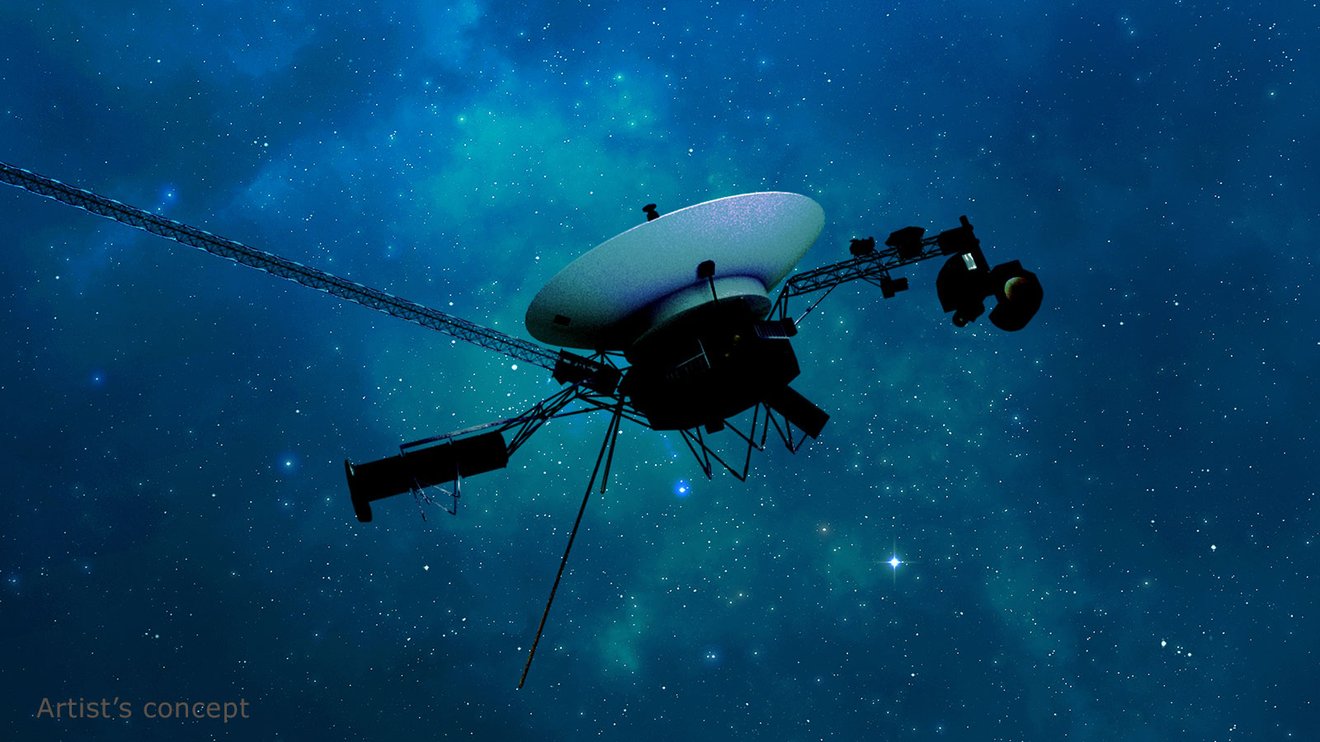
Voyager 1 and its twin Voyager 2 are the only spacecraft ever to operate outside the heliosphere, the protective bubble of particles and magnetic fields generated by the Sun. Voyager 1 reached the interstellar boundary in 2012, while Voyager 2 (traveling slower and in a different direction than its twin) reached it in 2018.
Mission Type
Science Targets
Featured News
Ed Stone, Former Director of JPL, Voyager Project Scientist, Dies

Voyager 1 Returning Science Data From All Four Instruments

NASA’s Voyager Will Do More Science With New Power Strategy
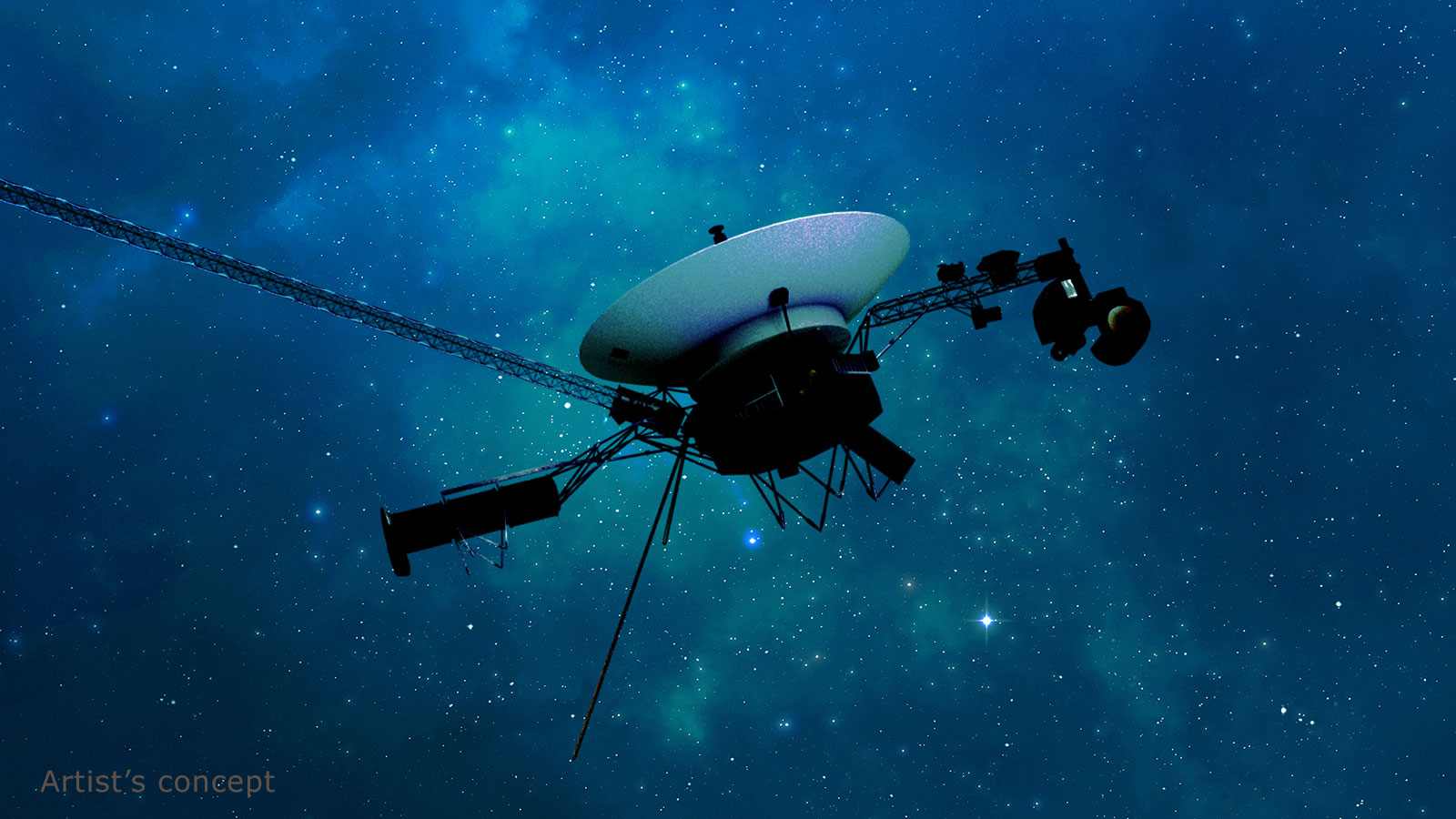
NASA’s Voyager Team Focuses on Software Patch, Thrusters
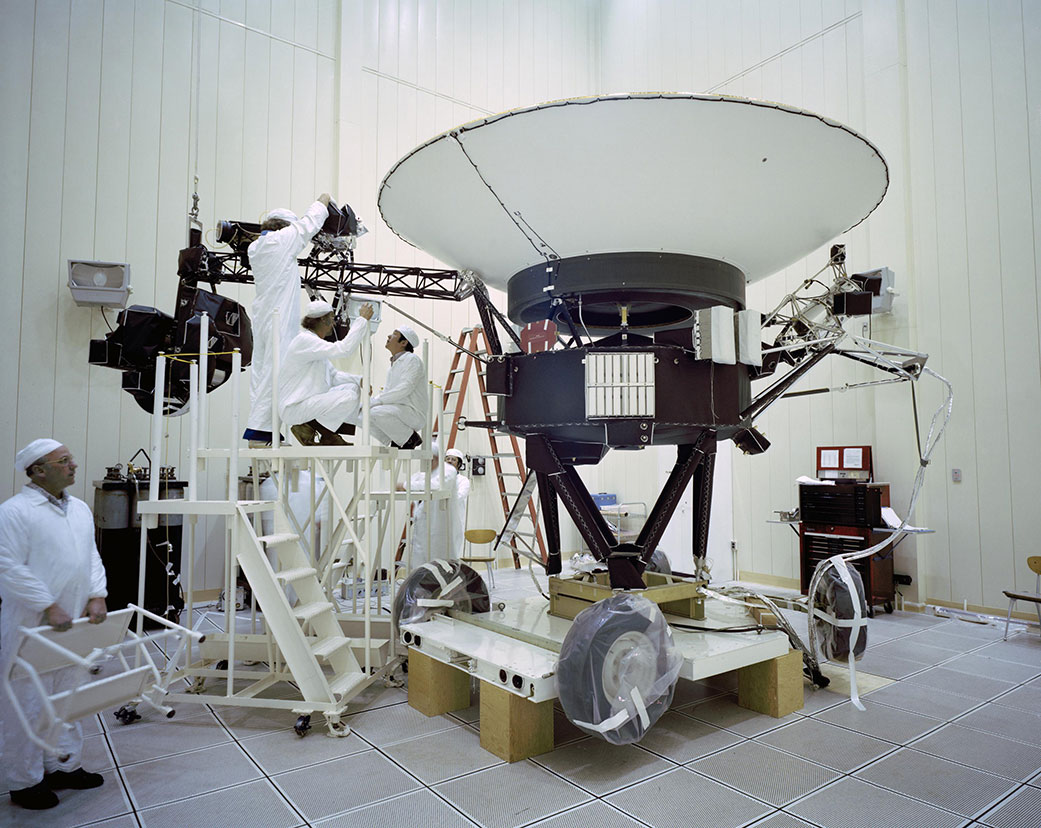
Voyager, NASA’s Longest-Lived Mission, Logs 45 Years in Space
Voyager Blog
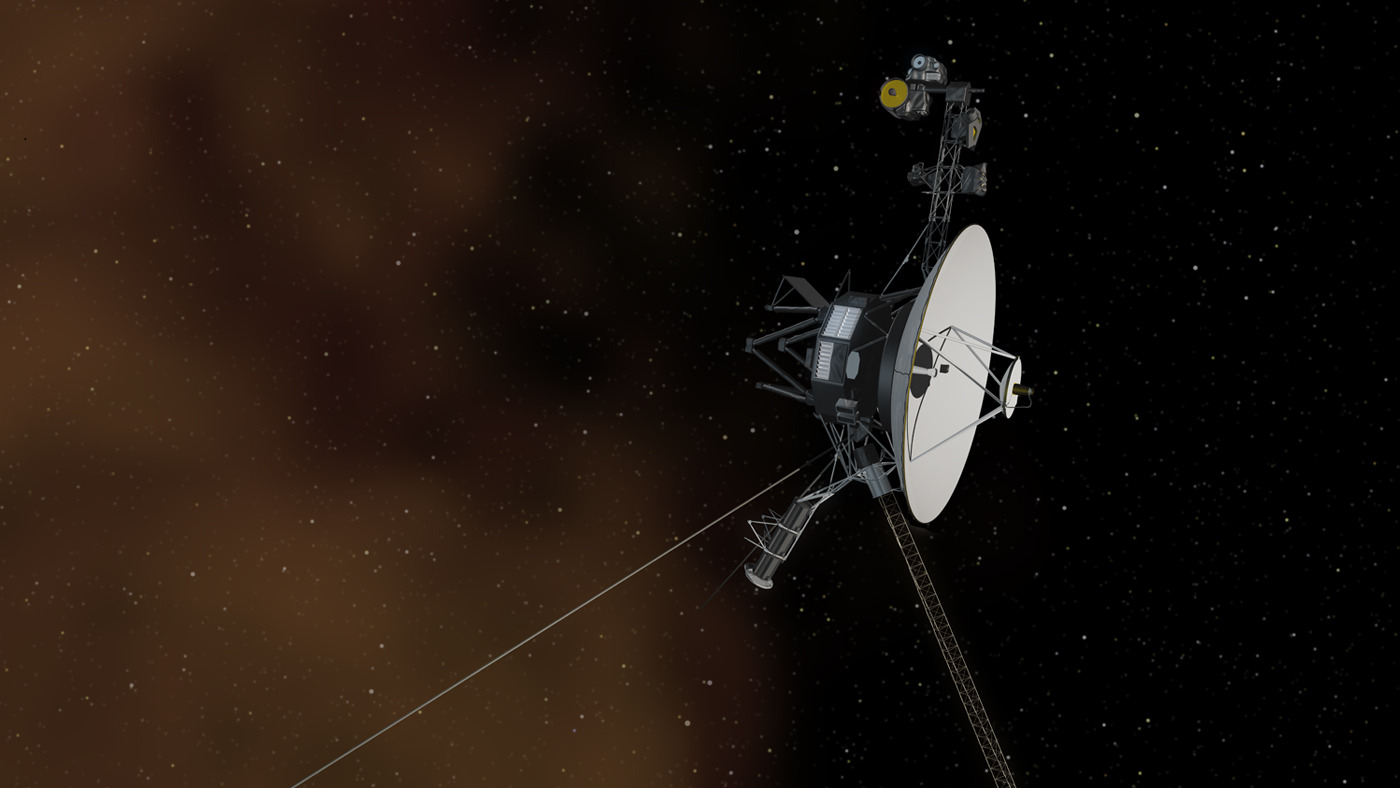
Mission Updates
Voyager 1 Resumes Sending Science Data from Two Instruments
The Interstellar Mission
After completing the first in-depth reconnaissance of the outer planets, the twin Voyagers are on a new mission to chart the edge of interstellar space.
The Golden Record
The contents of the golden record were selected for NASA by a committee led by Carl Sagan of Cornell University.
The Spacecraft
The twin Voyagers are escaping our solar system in different directions at more than 3 astronomical units (AU) a year.
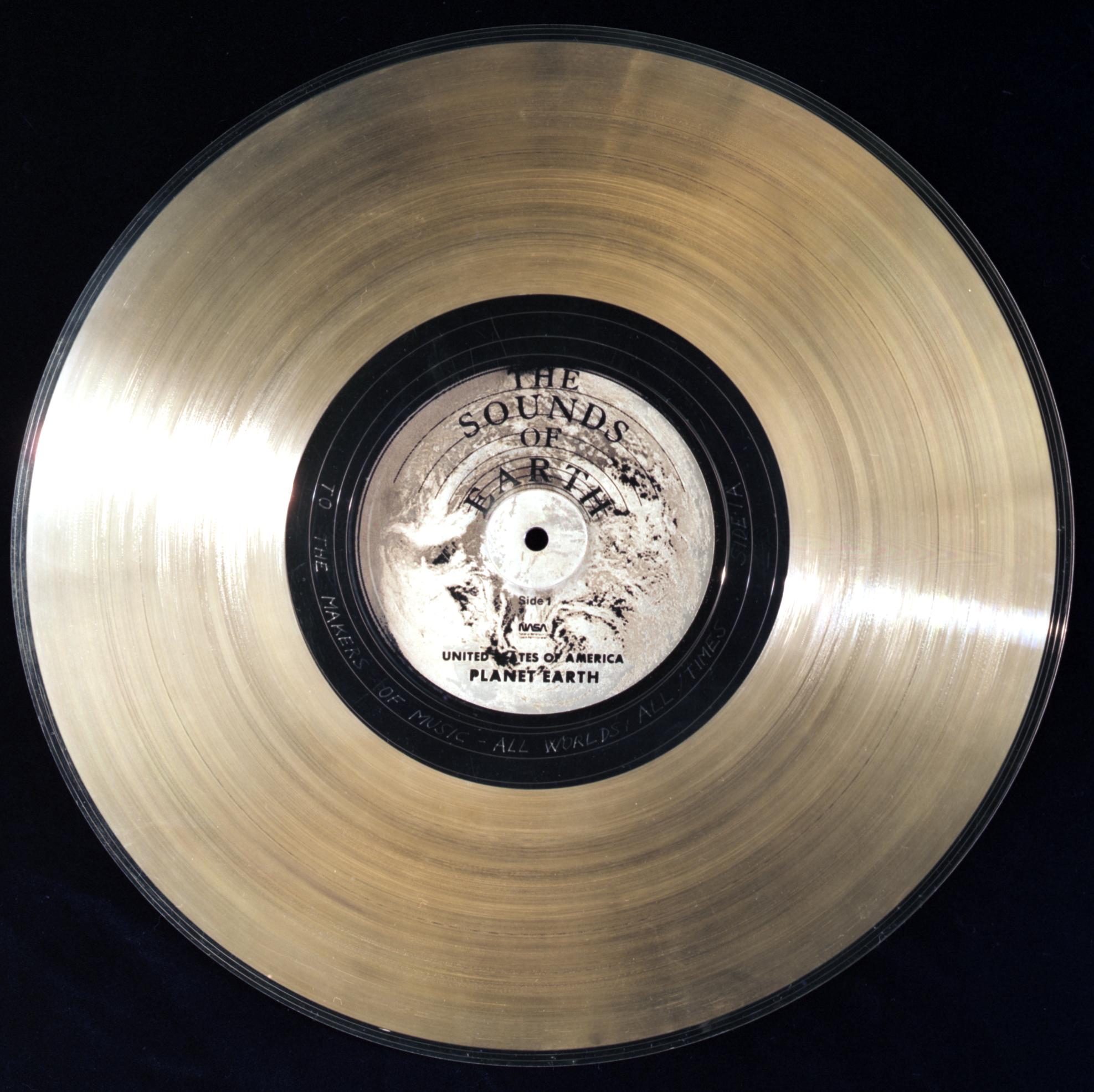
The Pale Blue Dot
The behind-the-scenes story of the making of Voyager 1's iconic image of Earth as "a mote of dust suspended in a sunbeam."
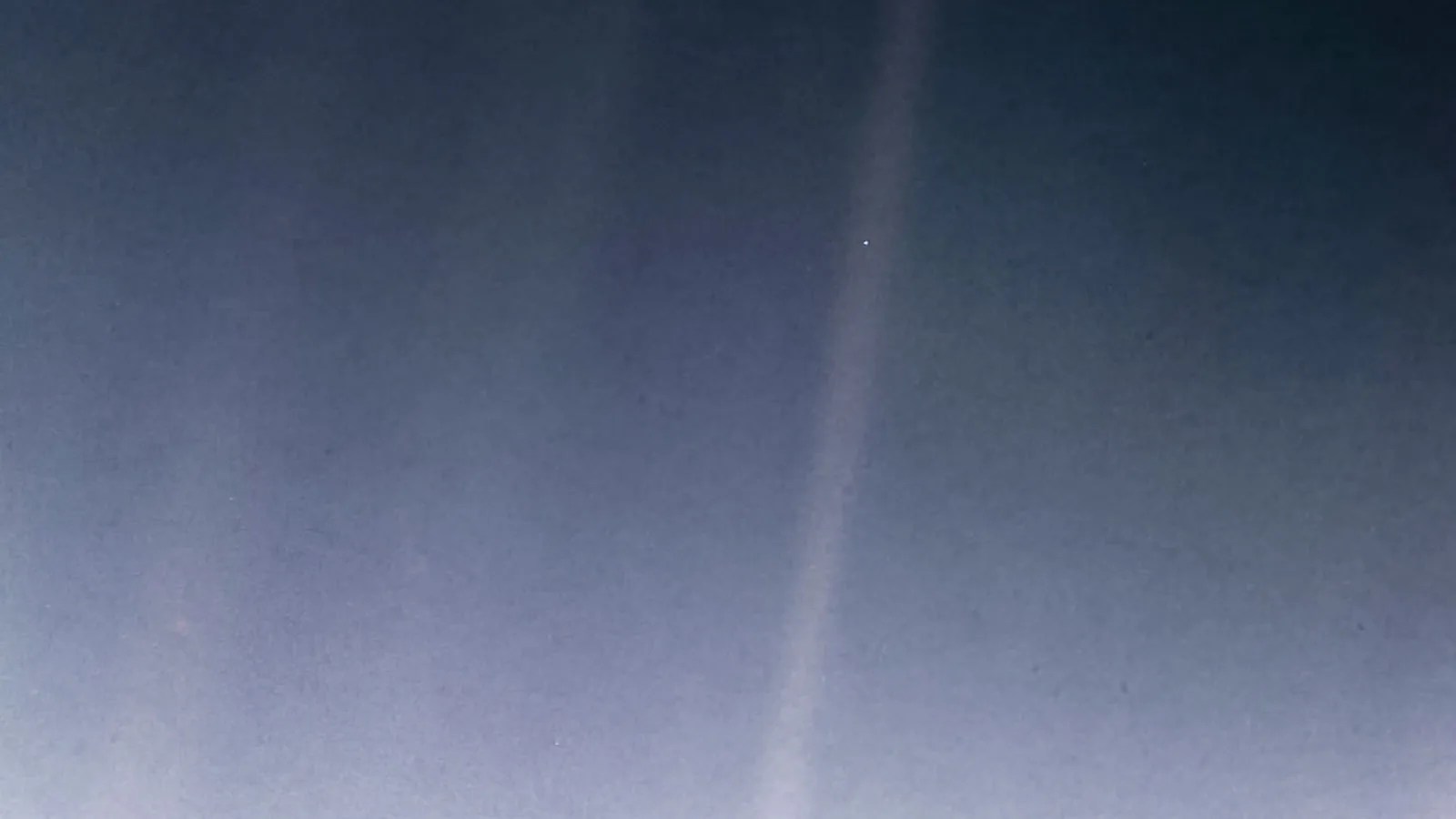
Discover More Topics From NASA


Way out in interstellar space, Voyager 1 is roaming where no human has ever been, revealing secrets of our universe more than 15 billion miles away. Today, the story of its nearly 50-year journey through space and the scientists trying to keep it with us.

Voyager 1 launched on Sept. 5, 1977, during the height of the space age. In the decades since, this unmanned spacecraft has ventured to the outer edges of our universe, sending back one-of-a-kind images and exploring realms that humans will probably never reach.
Voyager 1 is now more than 15 billion miles away in interstellar space, still collecting data and sending it back to Earth. But late last year, Voyager 1 faced its biggest crisis yet. It went silent and stopped communicating. In the months that followed, scientists at NASA launched an all-hands-on-deck effort to find a solution.
Today on “Post Reports,” science reporter Joel Achenbach on Voyager’s journey through space, its fragile future and the desperate effort to keep it with us. We hear from Linda Spilker, project scientist for Voyager 1, and David Cummings, a member of a “tiger team” at NASA’s Jet Propulsion Laboratory.
Today’s show was produced by Elana Gordon. It was edited by Peter Bresnan and mixed by Sean Carter. Thanks to Stephen Smith.
Subscribe to The Washington Post here .
Enable the Flash Briefing in the Amazon Skill store or search for "The Washington Post" in the Skill section of your Alexa app. Then ask, "Alexa, what's my Flash Briefing?" or "Alexa, what's the news?"
Send Post Reports to your Google Assistant device or say, "Okay Google, play the news from Post Reports."

What the Secret Service got wrong
Today, a deep dive into the Secret Service and their response to the attempted assassination of former president Donald Trump.

How the 1984 Olympics saved the Games
With only days before the Opening Ceremonies kick off the 2024 Summer Olympics in Paris, we go back to 1984 – when the Games faced international ruin and were reinvented in Los Angeles.
More podcasts

Voyager 1 Launch (1977)

This photograph from Sept. 5, 1977, shows the launch of NASA's Voyager 1 spacecraft from NASA's Kennedy Space Center at Cape Canaveral, Fla.
The Voyager spacecraft were built and continue to be operated by NASA's Jet Propulsion Laboratory, in Pasadena, Calif. Caltech manages JPL for NASA. The Voyager missions are a part of NASA's Heliophysics System Observatory, sponsored by the Heliophysics Division of the Science Mission Directorate at NASA Headquarters in Washington.
For more information about Voyager, visit http://www.nasa.gov/voyager and http://voyager.jpl.nasa.gov .

Missy Elliott’s ‘The Rain’: NASA beams 1st hip-hop song to Venus in 14 mins
T he universe is vast. But for one iconic artist, the stars just got a little closer. For the first time, NASA sent hip-hop music into outer space.
NASA’s Deep Space Network (DSN) sent the lyrics from Missy Elliott’s hit song “The Rain (Supa Dupa Fly)” on a cosmic journey to Venus.
California’s Jet Propulsion Lab initiated the transmission on July 12 at 10:05 AM PDT.
“I still can’t believe I’m going out of this world with NASA through the Deep Space Network when “The Rain” (Supa Dupa Fly) becomes the first ever hip-hop song to transmit to space!,” said Elliott in the NASA release.
Transmitted via radio signal
This 1997 chart-topping hit (“The Rain” peaked at #4 on Billboard’s R&B/Hip-Hop chart) began Missy Elliott’s solo career following her stint with an R&B group.
Elliott, also known as Misdemeanor, has always pushed boundaries. Her music videos are known for their space-age themes and out-of-this-world visuals.
“Both space exploration and Missy Elliott’s art have been about pushing boundaries,” said Brittany Brown, director of the Digital and Technology Division, Office of Communications at NASA Headquarters in Washington.
“Missy has a track record of infusing space-centric storytelling and futuristic visuals in her music videos so the opportunity to collaborate on something out of this world is truly fitting,” Brown added.
Traveling at the speed of light, the song raced 158 million miles (254 million kilometers) from Earth, arriving at Venus in just 14 minutes via radio signals.
The historic radio signal transmission blasted off from a 34-meter (112-foot) wide radio antenna (Deep Space Station 13) nicknamed “Venus.” DSS 13 is located at NASA’s Goldstone Deep Space Communications Complex in California.
Elliot’s favorite planet
Interestingly, Venus was picked specifically since it is Elliot’s favorite planet.
Elliot said: “I chose Venus because it symbolizes strength, beauty, and empowerment and I am so humbled to have the opportunity to share my art and my message with the universe!”
Venus is often called as E arth’s evil twin. The planet is shrouded in a thick, scorching atmosphere of carbon dioxide and sulfuric acid clouds. With an average temperature hot enough to melt lead (867°F), it is not a welcoming environment.
As per NASA’s release , the space agency is sending two new missions to Venus, and the DSN will be there to help. NASA’s DAVINCI mission targeting Venus’ atmosphere is set to lift off sometime after 2029, followed by its companion mission, VERITAS, in 2031 or later.
The DSN is a network of powerful radio antennas that act as Earth’s messengers, sending commands and receiving data from spacecraft exploring the Moon and beyond.
Music has been a part of NASA’s cosmic messages for decades. Back in 1965, astronauts enjoyed a parody of “Hello, Dolly!” while in orbit around Earth.
Meanwhile, the Voyager missions carry golden records, a mixtape of Earth’s sounds, as they go beyond the solar system. Who knows, maybe some alien civilization will one day find these songs and get a taste of Earth’s music.


- The Contents
- The Making of
- Where Are They Now
Frequently Asked Questions
- Q & A with Ed Stone
golden record
Where are they now.
- frequently asked questions
- Q&A with Ed Stone
Can the Voyager imaging cameras be turned back on?
What instruments on the spacecraft are still working and what have been turned off?
How long can Voyager 1 and 2 continue to function?
Voyager 1 is expected to keep its current suite of science instruments on through 2021. Voyager 2 is expected to keep its current suite of science instruments on through 2020.
The radioisotope thermoelectric generator on each spacecraft puts out 4 watts less each year. Because of this diminishing electrical power, the Voyager team has had to prioritize which instruments to keep on and which to turn off. Heaters and other spacecraft systems have also been turned off one by one as part of power management.
The Voyager team has chosen to keep operating the instruments that are the most likely to send back key data about the heliosphere and interstellar space -- the fields and particles instruments. Engineers expect to begin turning off fields and particles science instruments one by one, starting in 2020 for Voyager 2. Voyager 2 will have to start turning science instruments off sooner because it is currently operating one more instrument than Voyager 1. Engineers expect each spacecraft to continue operating at least one science instrument until around 2025.
Even if science data won't likely be collected after 2025, engineering data could continue to be returned for several more years. The two Voyager spacecraft could remain in the range of the Deep Space Network through about 2036, depending on how much power the spacecraft still have to transmit a signal back to Earth.
Where are Voyager 1 and 2 today? How do they compare to other spacecraft on an outbound trajectory?
Where is Voyager 1 going? When will it get there? How about Voyager 2?
Where do we consider our solar system to end; Pluto's orbit? Solar apex?
Have any human-made objects ever exited the solar system?
Are the distance counters rolling backwards?
Did either of the Voyagers visit Pluto? Why didn't the Voyagers fly by Pluto?
When we send spacecraft through the asteroid belt to the outer planets, how do we navigate the craft through the belt?
I was reading Dr. Carl Sagan's biography recently and found that he persuaded NASA administrators to turn one of the Voyager space probes around in order to take a last image of the solar system. Is this true? Do the craft send back any images of where they are?
I can not locate a copy of the Murmurs of Earth CD. Would you know of a vendor that might sell copies of it?
Who was on the committee with Dr. Sagan regarding the development of the Golden Record? Both American or foreign scientists?
If there is intelligent life in our universe and they were not a peace loving species, wouldn't the information on the Voyager be enough to destroy human kind?
What were the most important discoveries of the Voyager space probes?
How big is Voyager? How much does it weigh?
Is it true that a sketch by Da Vinci is included in the "Message to the Universe" of Voyagers 1 and 2?
What kind of computers are used on the Voyager spacecraft?
How fast are the Voyager computers?
What is the "direction" (constellation and/or star) both VOYAGER 1 & 2 and the Pioneers are "aimed" for, at present.
Where can I find pictures of what the Voyager spacecraft took?
Is there some sort of plate with pictograms on the Voyager 1 spacecraft? Also is it similar to the Pioneer spacecraft plaque?

IMAGES
VIDEO
COMMENTS
Voyager 1 ' s launch almost failed because Titan's LR-91 second stage shut down prematurely, leaving 1,200 pounds (540 kg) of propellant unburned. Recognizing the deficiency, the Centaur stage's on-board computers ordered a burn that was far longer than planned in order to compensate.
Voyager 1 lifted off on Sept. 5, 1977, atop a Titan IIIE-Centaur rocket from Launch Complex 41 at Cape Canaveral Air Force Station, now Cape Canaveral Space Force Station, in Florida. Two weeks after its launch, from a distance of 7.25 million miles, Voyager 1 turned its camera back toward its home planet and took the first single-frame image ...
New video of Voyager 1 launch https://youtu.be/ToSFMq7UiPIThe Voyager 1 probe was launched on September 5, 1977 on a Titan IIIE/Centaur launch vehicle. Voyag...
Voyager 1 Voyager 2; Launch Date: Mission Elapsed Time ... Both Voyager 1 and Voyager 2 have reached "Interstellar space" and each continue their unique journey through the Universe. In the NASA Eyes on the Solar System app, you can see the real spacecraft trajectories of the Voyagers, which are updated every five minutes. ...
On September 5, 1977, NASA 's Voyager 1 spacecraft lifted off atop its Titan/Centaur-6 launch vehicle from Launch Complex 41 at Cape Canaveral Air Force Station, now Cape Canaveral Space Force Station, in Florida. Voyager 1 and its twin, Voyager 2, were originally launched to conduct closeup studies of Jupiter and Saturn, Saturn's rings, and the larger moons of the two planets.
Voyager 1 has been exploring our solar system since 1977. The probe is now in interstellar space, the region outside the heliopause, or the bubble of energetic particles and magnetic fields from the Sun. Voyager 1 was launched after Voyager 2, but because of a faster route it exited the asteroid belt earlier than its twin, and it overtook Voyager 2 on Dec. 15, 1977.
The twin Voyager 1 and 2 spacecraft are exploring where nothing from Earth has flown before. Continuing on their more-than-40-year journey since their 1977 launches, they each are much farther away from Earth and the sun than Pluto. ... Launch: Voyager 2 launched on August 20, 1977, from Cape Canaveral, Florida aboard a Titan-Centaur rocket. On ...
Sept. 1, 2013. September 2013: After intensive analysis, mission scientists determine that Voyager 1 reached interstellar space in August 2012. Interactive 3D model of Voyager 1. View the full interactive experience at Eyes on the Solar System. Launch and mission summary for NASA's Voyager 1 mission to Jupiter, Saturn and beyond.
5 September 2021 marks the 45th anniversary of the Voyager 1 launch! Formerly known as Mariner Jupiter-Saturn 1977 or MJS77, Voyager is the most distant artificial object from Earth. Launched just 16 days after its twin spacecraft, Voyager 2, Voyager 1 began its exploration of the Jovian and Saturnian systems, discovering new moons, active ...
As of Friday (Sept. 1), Voyager 1 was a whopping 12.97 billion miles (20.87 billion kilometers) from Earth — more than 139 times the distance from our planet to the sun. Voyager 2 was about 10. ...
Voyager 1 was the second of the twin spacecraft to launch, but it was the first to race by Jupiter and Saturn.The images Voyager 1 sent back have been used in schoolbooks and by many media outlets ...
The cost of the Voyager 1 and 2 missions -- including launch, mission operations from launch through the Neptune encounter and the spacecraft's nuclear batteries (provided by the Department of Energy) -- is $865 million. NASA budgeted an additional $30 million to fund the Voyager Interstellar Mission for two years following the Neptune encounter.
At approximately 2:10 p.m. Pacific time on February 17, 1998, Voyager 1, launched more than two decades ago, will cruise beyond the Pioneer 10 spacecraft and become the most distant human-created object in space at 10.4 billion kilometers (6.5 billion miles.) The two are headed in almost opposite directions away from the Sun.
Voyager 1 Launch. July 5, 2017. NASA's Voyager 1 spacecraft launched atop its Titan/Centaur-6 launch vehicle from the Kennedy Space Center Launch Complex in Florida on September 5, 1977, at 8:56 a.m. local time. Voyager is managed for NASA by NASA's Jet Propulsion Laboratory, Pasadena, California. JPL is a division of the California Institute ...
Liftoff of the Voyager 1 probe on September 5, 1977, on a Titan IIIE/Centaur launch vehicle. (Voyager 2 was launched before, on August 20, 1977 https://youtu...
The Voyager 1 mission. MISSION INFORMATION: Launch date: 09/05/1977, 12:56:00 UTC. Launch vehicle: Titan IIIE / Centaur. Launch site: Space Launch Complex 41, Cape Canaveral Air Force Station. Mission duration: In progress (Interstellar mission) Digitized, cataloged and archived by the Houston Audio Control Room, at the NASA Johnson Space Center.
Voyager 2 launch aboard Titan-Centaur rocket. › larger image. Launch. Voyager 2 launched on August 20, 1977, from Cape Canaveral, Florida aboard a Titan-Centaur rocket. On September 5, Voyager 1 launched, also from Cape Canaveral aboard a Titan-Centaur rocket. ... Voyager 1 is escaping the solar system at a speed of about 3.6 AU per year.
Rockets aren't the only thing we launch. Welcome to our improved NASA website! If you don't find what you are looking for, please try searching above, give us feedback , or return to the main site . Sitemap Submit Feedback. Voyager 1 and its twin Voyager 2 are the only spacecraft ever to reach the edge of interstellar space..
Although other probes were launched first, Voyager 1 was able to achieve a higher speed and has overtaken all others. Voyager 1 overtook Voyager 2 a few months after launch, on 19 December 1977. It overtook Pioneer 11 some time in the late 1980s, and then Pioneer 10—becoming the probe farthest from Earth—on February 17, 1998.
Voyager 1 Returning Science Data From All Four Instruments News . NASA's Perseverance Fords an Ancient River to Reach Science Target About JPL Who We Are Executive Council Directors Careers Internships The JPL Story JPL Achievements Documentary Series ...
Voyager 1 launched on Sept. 5, 1977, during the height of the space age. In the decades since, this unmanned spacecraft has ventured to the outer edges of our universe, sending back one-of-a-kind ...
Site Manager: Jon Nelson Webmasters: Anil Natha, Luis Espinoza Webmasters: Anil Natha, Luis Espinoza
The show also was the first attempt to launch a Paramount-focused broadcast/streaming service, with 1995's UPN (United Paramount Network). ... Voyager's impact on the franchise and sci-fi as a ...
Sept. 19, 2013. This photograph from Sept. 5, 1977, shows the launch of NASA's Voyager 1 spacecraft from NASA's Kennedy Space Center at Cape Canaveral, Fla. The Voyager spacecraft were built and continue to be operated by NASA's Jet Propulsion Laboratory, in Pasadena, Calif. Caltech manages JPL for NASA.
NASA GETS VOYAGER 1 BACK ONLINE FROM 15 BILLION MILES AWAY AFTER TECHNICAL PROBLEM ... China's Chang'e-6 lunar mission rocket prepares to lift off from the Wenchang Satellite Launch Center in ...
NASA's DAVINCI mission targeting Venus' atmosphere is set to lift off sometime after 2029, followed by its companion mission, VERITAS, in 2031 or later. ... Meanwhile, the Voyager missions ...
The Voyager spacecraft weight, including hydrazine, at launch was 815 kg or about 1797 pounds. It was almost the weight and size of a sub-compact car. The current approximate weight of Voyager 1 is 733 kg and Voyager 2 is 735 kg. ... Voyager 1 is escaping the solar system at a speed of about 3.5 AU per year, 35 degrees out of the ecliptic plane ...